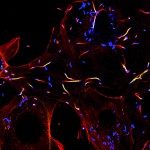Lien vers Pubmed [PMID] – 21317388
J. Immunol. 2011 Mar;186(6):3289-93
Despite their increasing use in autoimmune, inflammatory, and allergic conditions, the mechanism of action of i.v. Igs (IVIg) is poorly understood. On the basis of the critical role of invariant NKT (iNKT) cells in allergic airway inflammation (AAI) and their constitutive expression of the low-affinity IgG receptor FcγRIIIA, we surmised that IVIg targets iNKT cells to exert their anti-inflammatory effect. We found that IVIg treatment significantly inhibited AAI in OVA-sensitized C57BL/6 mice and downregulated α-galactosylceramide-induced iNKT cell activation and cytokine production. Allergic responses were restored in iNKT cell-deficient mice by transferring iNKT cells from PBS- but not from IVIg-treated mice, suggesting that IVIg acts directly on activated iNKT cells that have a critical role in AAI. The inhibitory effects of IVIg on both iNKT cell activation/function and OVA-driven AAI were lost in FcγRIIIA(-/-) mice. Our data unravel an FcγRIIIA-dependent inhibitory effect of IVIg on activated iNKT cells that confers protection in AAI.
